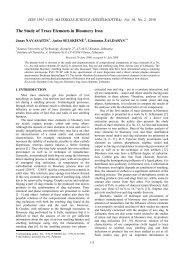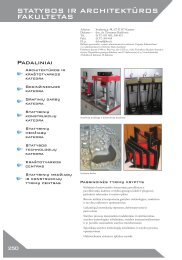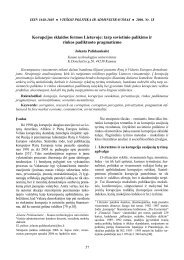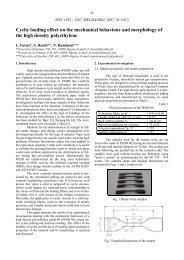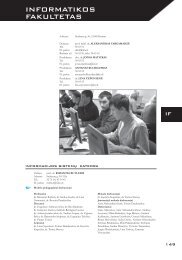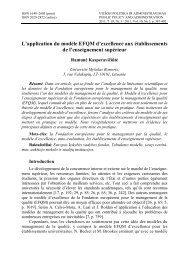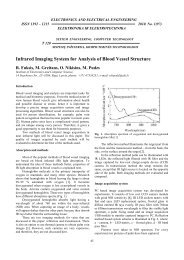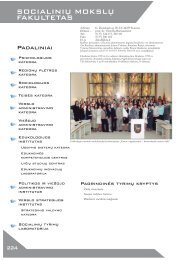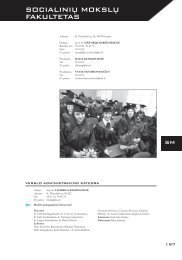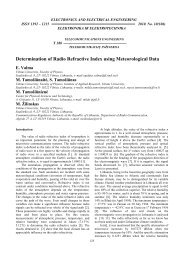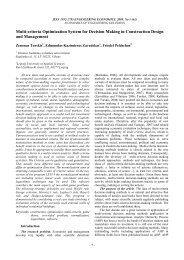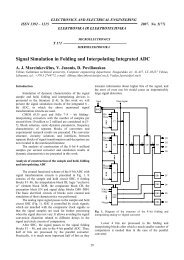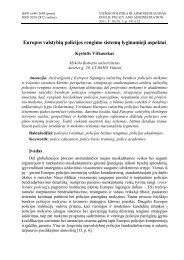a motivation study on the effectiveness of intrinsic
a motivation study on the effectiveness of intrinsic
a motivation study on the effectiveness of intrinsic
Create successful ePaper yourself
Turn your PDF publications into a flip-book with our unique Google optimized e-Paper software.
ISSN 1822-6515 ISSN 1822-6515<br />
EKONOMIKA IR VADYBA: 2011. 16 ECONOMICS AND MANAGEMENT: 2011. 16<br />
A MOTIVATION STUDY ON THE EFFECTIVENESS OF INTRINSIC<br />
AND EXTRINSIC FACTORS<br />
Orhan Çınar 1 , Çetin Bektaş 2 , Imran Aslan 3<br />
1 The University <strong>of</strong> Erzincan, Turkey, orhanar@gmail.com<br />
2<br />
The University <strong>of</strong> Erzincan, Turkey, cbektas@erzincan.edu.tr<br />
3 The University <strong>of</strong> Erzincan, Turkey, iaslan@erzincan.edu.tr, imranaslan@gmail.com<br />
Abstract<br />
Motivati<strong>on</strong> has l<strong>on</strong>g been <strong>on</strong>e <strong>of</strong> management’s most difficult and important duties. Success in this<br />
subject is becoming more challenging in organizati<strong>on</strong>al trends because business envir<strong>on</strong>ment changes quickly<br />
and becomes more competitive. Researches <strong>on</strong> employee <str<strong>on</strong>g>motivati<strong>on</strong></str<strong>on</strong>g> especially highlight two types <strong>of</strong> factors:<br />
<strong>intrinsic</strong> and extrinsic.<br />
The purpose <strong>of</strong> this <str<strong>on</strong>g>study</str<strong>on</strong>g> it is to find out <strong>the</strong> <strong>effectiveness</strong> <strong>of</strong> <strong>intrinsic</strong> and extrinsic factors <strong>on</strong><br />
employee <str<strong>on</strong>g>motivati<strong>on</strong></str<strong>on</strong>g>, which <strong>on</strong>e is more effective and compare <strong>the</strong>m according to demographic<br />
characteristics <strong>of</strong> employees. Using descriptive survey design, <strong>the</strong> sample <strong>of</strong> <strong>the</strong> <str<strong>on</strong>g>study</str<strong>on</strong>g> was 41 employees <strong>of</strong><br />
an electricity delivery company located in <strong>the</strong> province <strong>of</strong> Ağrı, Eastern Anatolia, Turkey.<br />
As a result <strong>of</strong> <strong>the</strong> <str<strong>on</strong>g>study</str<strong>on</strong>g> it is found out that both <strong>intrinsic</strong> and extrinsic factors affect employees while<br />
<strong>the</strong>y achieve <strong>the</strong>ir tasks. Ano<strong>the</strong>r result is that <strong>intrinsic</strong> factors are more motivating than extrinsic factors.<br />
Being <strong>the</strong> first <strong>on</strong>e in <strong>the</strong> province <strong>of</strong> Ağrı, this <str<strong>on</strong>g>study</str<strong>on</strong>g> is meaningful and valuable.<br />
Keywords: Motivati<strong>on</strong>, Intrinsic Factors, Extrinsic Factors.<br />
JEL Classificati<strong>on</strong>: D23.<br />
Introducti<strong>on</strong><br />
In order to be successful or even more successful, today’s both private and public work organizati<strong>on</strong>s<br />
need to maximize <strong>the</strong> use <strong>of</strong> <strong>the</strong>ir employees’ skills. Human resource is <strong>the</strong> most critical resource for any<br />
organizati<strong>on</strong> in today’s highly competitive business envir<strong>on</strong>ment. The primary task <strong>of</strong> any manager is to<br />
have an organizati<strong>on</strong> that functi<strong>on</strong>s effectively. To do so, subordinates must work efficiently and produce<br />
results that are beneficial to <strong>the</strong> organizati<strong>on</strong>.<br />
It is obvious that <str<strong>on</strong>g>motivati<strong>on</strong></str<strong>on</strong>g> is <strong>on</strong>e <strong>of</strong> <strong>the</strong> main factors that determine <strong>the</strong> work performance <strong>of</strong><br />
employees and highly motivated employees are crucial to an organizati<strong>on</strong>'s success. But what does<br />
<str<strong>on</strong>g>motivati<strong>on</strong></str<strong>on</strong>g> really represent or why people behave as <strong>the</strong>y do? Motivati<strong>on</strong> <strong>the</strong>ories have aimed to answer this<br />
questi<strong>on</strong>. If we know what drives <strong>the</strong> people <strong>the</strong>n we are able to make <strong>the</strong>m to do what we want (Owens,<br />
2004; Eren, 2007; Koçel, 2010).<br />
The term <str<strong>on</strong>g>motivati<strong>on</strong></str<strong>on</strong>g> derives from <strong>the</strong> Latin word movere, meaning “to move” (Tansky, 2003). In <strong>the</strong><br />
present c<strong>on</strong>text, <str<strong>on</strong>g>motivati<strong>on</strong></str<strong>on</strong>g> represents <strong>the</strong> process that arouses, energizes, directs, and sustains behaviour and<br />
performance (Luthans, 1998). That is, it is <strong>the</strong> process <strong>of</strong> stimulating people to acti<strong>on</strong> and to achieve a<br />
desired task. In brief, it can be said that a pers<strong>on</strong> is motivated when he/she wants to do something.<br />
Motivati<strong>on</strong> is a tool with which managers can use in organizati<strong>on</strong>s. If managers know what drives <strong>the</strong> people<br />
working for <strong>the</strong>m, <strong>the</strong>y can set job assignments and rewards to what stimulates <strong>the</strong>se people.<br />
Motivati<strong>on</strong> is a multidimensi<strong>on</strong>al framework because people are usually motivated by a combinati<strong>on</strong><br />
<strong>of</strong> different factors. Being a complex topic <strong>of</strong> research <str<strong>on</strong>g>motivati<strong>on</strong></str<strong>on</strong>g> has been studied from many different<br />
approaches. Reinholt (2006) argue that <strong>the</strong> organizati<strong>on</strong>al science literature <strong>on</strong> <str<strong>on</strong>g>motivati<strong>on</strong></str<strong>on</strong>g> has for l<strong>on</strong>g been<br />
polarized into two main positi<strong>on</strong>s; <strong>the</strong> organizati<strong>on</strong>al ec<strong>on</strong>omic positi<strong>on</strong> focusing <strong>on</strong> extrinsic <str<strong>on</strong>g>motivati<strong>on</strong></str<strong>on</strong>g> and<br />
<strong>the</strong> organizati<strong>on</strong>al behaviour positi<strong>on</strong> emphasizing <strong>intrinsic</strong> <str<strong>on</strong>g>motivati<strong>on</strong></str<strong>on</strong>g>. She c<strong>on</strong>tinued that <strong>the</strong> organizati<strong>on</strong>al<br />
ec<strong>on</strong>omic approach and <strong>the</strong> organizati<strong>on</strong>al behaviour approach to human <str<strong>on</strong>g>motivati<strong>on</strong></str<strong>on</strong>g> and behaviour, hence<br />
both <strong>intrinsic</strong> <str<strong>on</strong>g>motivati<strong>on</strong></str<strong>on</strong>g> and extrinsic <str<strong>on</strong>g>motivati<strong>on</strong></str<strong>on</strong>g>, are needed to analyze and understand <str<strong>on</strong>g>motivati<strong>on</strong></str<strong>on</strong>g> and<br />
behaviour in organizati<strong>on</strong>s.<br />
Motivati<strong>on</strong> Theories<br />
Employees were c<strong>on</strong>sidered as solely <strong>on</strong>e <strong>of</strong> <strong>the</strong> inputs <strong>of</strong> <strong>the</strong> producti<strong>on</strong> system in <strong>the</strong> initial stages <strong>of</strong><br />
<strong>the</strong> industrial revoluti<strong>on</strong>. It was <strong>the</strong> Hawthorne Studies c<strong>on</strong>ducted by Elt<strong>on</strong> Mayo from 1924 to 1932 that<br />
revealed <strong>the</strong> shift in <strong>the</strong> percepti<strong>on</strong> about employees by organizati<strong>on</strong>s. These studies c<strong>on</strong>cluded that<br />
employees are not motivated merely by m<strong>on</strong>ey and that employee behaviour is linked to <strong>the</strong>ir attitudes. The<br />
690
ISSN 1822-6515 ISSN 1822-6515<br />
EKONOMIKA IR VADYBA: 2011. 16 ECONOMICS AND MANAGEMENT: 2011. 16<br />
Hawthorne Studies began <strong>the</strong> human relati<strong>on</strong>s approach to management, and <strong>the</strong>n <strong>the</strong> needs and <str<strong>on</strong>g>motivati<strong>on</strong></str<strong>on</strong>g><br />
<strong>of</strong> employees become an important topic for managers (Kulkarni and Chiniwar, 2009).<br />
The most influent <strong>the</strong>ory is Maslow's Hierarchy <strong>of</strong> Needs. Maslow (1943) advanced <strong>the</strong> following<br />
important prepositi<strong>on</strong>s about human behaviour: humans want beings (<strong>the</strong>y always want, and <strong>the</strong>y want<br />
more), a satisfied need is not a motivator <strong>of</strong> behaviour and human needs are arranged in a series <strong>of</strong> levels-a<br />
hierarchy <strong>of</strong> importance. Maslow classified people needs in 5 categories: physiological, safety, social (sense<br />
<strong>of</strong> bel<strong>on</strong>ging), esteem and self-realizati<strong>on</strong> needs. Maslow said that, when an inferior rank need is satisfied<br />
(for example, assuring food, clothing, <strong>the</strong> need <strong>of</strong> breathing, etc), <strong>the</strong> next level need becomes dominant, and<br />
<strong>the</strong> attenti<strong>on</strong> <strong>of</strong> <strong>the</strong> pers<strong>on</strong> is dedicated to <strong>the</strong> accomplishment <strong>of</strong> this higher rank need. He menti<strong>on</strong>ed that<br />
<strong>on</strong>ly an unsatisfied need can motivate <strong>the</strong> behaviour, <strong>the</strong> dominant need being <strong>the</strong> primary factor for<br />
behaviour <str<strong>on</strong>g>motivati<strong>on</strong></str<strong>on</strong>g>.<br />
In his research into human <str<strong>on</strong>g>motivati<strong>on</strong></str<strong>on</strong>g>, McClelland (Hicks and Gullett, 1981) identified three motives:<br />
affiliati<strong>on</strong>, power and achievement. According to achievement <strong>the</strong>ory individuals behave by <strong>on</strong>e or<br />
combinati<strong>on</strong>s <strong>of</strong> those needs. These needs corresp<strong>on</strong>d to <strong>the</strong> social, esteem and self-realizati<strong>on</strong> needs <strong>of</strong><br />
Maslow’s hierarchy.<br />
Ano<strong>the</strong>r <str<strong>on</strong>g>motivati<strong>on</strong></str<strong>on</strong>g> <strong>the</strong>ory is Frederick Herzberg's Two Factors Theory. Herzberg (1964) interviewed<br />
“white collar” employees and managers to determine those things that caused <strong>the</strong>m to be satisfied and<br />
dissatisfied. He identified five factors that most <strong>of</strong>ten c<strong>on</strong>tributed to employee dissatisfacti<strong>on</strong>: perceived<br />
fairness <strong>of</strong> company policy, pay, working c<strong>on</strong>diti<strong>on</strong>s, relati<strong>on</strong>s with <strong>on</strong>e’s supervisor, and relati<strong>on</strong>s with coworkers.<br />
He stated that to satisfy or motivate employees a different set <strong>of</strong> factors were needed. These<br />
satisfiers included achievement, recogniti<strong>on</strong>, <strong>the</strong> work itself, resp<strong>on</strong>sibility, and advancement. He labelled<br />
<strong>the</strong> factors that produce satisfacti<strong>on</strong> motivators and <strong>the</strong> factors that produce dissatisfacti<strong>on</strong> hygiene factors.<br />
He meant that <str<strong>on</strong>g>motivati<strong>on</strong></str<strong>on</strong>g> factors resulted from internal generators in employees and motivators produced<br />
satisfacti<strong>on</strong>, arising from <strong>intrinsic</strong> c<strong>on</strong>diti<strong>on</strong>s <strong>of</strong> <strong>the</strong> job itself. Motivati<strong>on</strong> and <strong>the</strong> increase <strong>of</strong> work<br />
performance could be <strong>on</strong>ly obtained through <strong>the</strong> acti<strong>on</strong> <strong>of</strong> <strong>the</strong> <str<strong>on</strong>g>motivati<strong>on</strong></str<strong>on</strong>g>al factors, which directly reflect <strong>the</strong><br />
c<strong>on</strong>tent <strong>of</strong> <strong>the</strong> executed work by <strong>the</strong> employee <strong>on</strong> his positi<strong>on</strong>. The c<strong>on</strong>textual factors represent <strong>on</strong>ly <strong>the</strong><br />
c<strong>on</strong>diti<strong>on</strong>s necessary for <strong>the</strong> executi<strong>on</strong> <strong>of</strong> work processes. This <strong>the</strong>ory implies that in order to advance job<br />
attitudes and productivity, managers should identify and c<strong>on</strong>centrate to both sets <strong>of</strong> characteristics.<br />
Those are three <strong>of</strong> <strong>the</strong> c<strong>on</strong>tent <strong>the</strong>ories. C<strong>on</strong>tent <strong>the</strong>ories emphasize <strong>the</strong> specific factors that motivate<br />
<strong>the</strong> employees, while <strong>the</strong> process <strong>the</strong>ories underlined <strong>the</strong> psychological forces that have an effect <strong>on</strong><br />
<str<strong>on</strong>g>motivati<strong>on</strong></str<strong>on</strong>g>. Below are some <strong>of</strong> process <strong>the</strong>ories.<br />
The expectancy <strong>the</strong>ory was initially elaborated by Vroom (1964) and <strong>the</strong>n developed by Porter and<br />
Lawler (1968). This <strong>the</strong>ory establishes a c<strong>on</strong>necti<strong>on</strong> between <strong>the</strong> employees’ <str<strong>on</strong>g>motivati<strong>on</strong></str<strong>on</strong>g> and <strong>the</strong>ir<br />
expectancies. The <str<strong>on</strong>g>motivati<strong>on</strong></str<strong>on</strong>g> is possible <strong>on</strong>ly when <strong>the</strong>re is a clear relati<strong>on</strong> between <strong>the</strong> work performance<br />
and its results and <strong>the</strong> results are means to satisfy a certain need. Porter and Lawler advocated structuring <strong>the</strong><br />
work envir<strong>on</strong>ment so that effective performance would lead to both <strong>intrinsic</strong> and extrinsic rewards, which<br />
would in turn produce total job satisfacti<strong>on</strong>. Intrinsic <str<strong>on</strong>g>motivati<strong>on</strong></str<strong>on</strong>g> involves people doing an activity because<br />
<strong>the</strong>y find it interesting and derive sp<strong>on</strong>taneous satisfacti<strong>on</strong> from <strong>the</strong> activity itself. Extrinsic <str<strong>on</strong>g>motivati<strong>on</strong></str<strong>on</strong>g>, in<br />
c<strong>on</strong>trast, requires an instrumentality between <strong>the</strong> activity and some separable c<strong>on</strong>sequences such as tangible<br />
or verbal rewards, so satisfacti<strong>on</strong> comes not from <strong>the</strong> activity itself but ra<strong>the</strong>r from <strong>the</strong> extrinsic<br />
c<strong>on</strong>sequences to which <strong>the</strong> activity leads.<br />
Skinner’s (Davis, 1987) operant c<strong>on</strong>diti<strong>on</strong>ing is based <strong>on</strong> a fundamental c<strong>on</strong>cept <strong>of</strong> learning <strong>the</strong>ory. In<br />
this <strong>the</strong>ory behaviour that is appropriately reinforced tends to be repeated while not reinforced or punished<br />
tends not to be repeated. Individuals will take those acti<strong>on</strong>s that lead to <strong>the</strong> rewards that <strong>the</strong>y want and will<br />
stop doing those things that result in result in no rewards or punishment. Behaviour is thus a functi<strong>on</strong> <strong>of</strong> <strong>the</strong><br />
reinforcements supplied by <strong>the</strong> envir<strong>on</strong>ment.<br />
The goal setting <strong>the</strong>ory states that <strong>the</strong> level <strong>of</strong> <str<strong>on</strong>g>motivati<strong>on</strong></str<strong>on</strong>g> and performance is higher when <strong>the</strong><br />
individual has specific objectives established and when <strong>the</strong>se objectives, even with a high level <strong>of</strong> difficulty,<br />
are accepted and are <strong>of</strong>fered a performance feedback (Lantham and Locke, 1979).<br />
The equity <strong>the</strong>ory, developed by Adams (1975) explains about <strong>the</strong> people percepti<strong>on</strong>s regarding <strong>the</strong><br />
way <strong>the</strong>y are treated in comparis<strong>on</strong> with o<strong>the</strong>rs. Actually, <strong>the</strong> <strong>the</strong>ory states that <strong>the</strong> people are higher<br />
motivated when <strong>the</strong>y are fairly treated and less motivated when <strong>the</strong>re is no equity between employees.<br />
A <strong>the</strong>ory called “Self-Determinati<strong>on</strong> Theory” claimed that human behaviour can be driven both by<br />
internal and external sources <strong>of</strong> <strong>the</strong> individual (Ryan and Deci, 2000). In Self-Determinati<strong>on</strong> Theory <strong>the</strong>re<br />
are different types <strong>of</strong> <str<strong>on</strong>g>motivati<strong>on</strong></str<strong>on</strong>g> based <strong>on</strong> <strong>the</strong> different reas<strong>on</strong>s or goals that give rise to an acti<strong>on</strong>. The most<br />
691
ISSN 1822-6515 ISSN 1822-6515<br />
EKONOMIKA IR VADYBA: 2011. 16 ECONOMICS AND MANAGEMENT: 2011. 16<br />
basic distincti<strong>on</strong> is between <strong>intrinsic</strong> <str<strong>on</strong>g>motivati<strong>on</strong></str<strong>on</strong>g> and extrinsic <str<strong>on</strong>g>motivati<strong>on</strong></str<strong>on</strong>g>. Intrinsic <str<strong>on</strong>g>motivati<strong>on</strong></str<strong>on</strong>g> refers to doing<br />
something because it is inherently interesting or enjoyable and extrinsic <str<strong>on</strong>g>motivati<strong>on</strong></str<strong>on</strong>g> refers to doing something<br />
because it leads to a separable outcome. Figure-1 graphically illustrates <strong>the</strong> various forms <strong>of</strong> <strong>intrinsic</strong> and<br />
extrinsic <str<strong>on</strong>g>motivati<strong>on</strong></str<strong>on</strong>g>.<br />
Figure 1. A tax<strong>on</strong>omy <strong>of</strong> human <str<strong>on</strong>g>motivati<strong>on</strong></str<strong>on</strong>g>. (Ryan and Deci, 2000)<br />
It can be seen that <strong>the</strong>re are two comm<strong>on</strong> perspectives <strong>on</strong> <str<strong>on</strong>g>motivati<strong>on</strong></str<strong>on</strong>g> in <strong>the</strong> organizati<strong>on</strong>al science<br />
literature: extrinsic <str<strong>on</strong>g>motivati<strong>on</strong></str<strong>on</strong>g> and <strong>intrinsic</strong> <str<strong>on</strong>g>motivati<strong>on</strong></str<strong>on</strong>g>. In a review <strong>of</strong> <strong>the</strong> literature <strong>on</strong> work <str<strong>on</strong>g>motivati<strong>on</strong></str<strong>on</strong>g>,<br />
Ambrose and Kulik (1999) stated that <strong>intrinsic</strong> <str<strong>on</strong>g>motivati<strong>on</strong></str<strong>on</strong>g> still is perceived to be highly dominant. On <strong>the</strong><br />
o<strong>the</strong>r hand it is said that both <strong>intrinsic</strong> <str<strong>on</strong>g>motivati<strong>on</strong></str<strong>on</strong>g> and extrinsic <str<strong>on</strong>g>motivati<strong>on</strong></str<strong>on</strong>g> are needed to analyze and<br />
understand <str<strong>on</strong>g>motivati<strong>on</strong></str<strong>on</strong>g> and behaviour in organizati<strong>on</strong>s (Reinholt, 2006).<br />
Objective <strong>of</strong> <strong>the</strong> Study<br />
This <str<strong>on</strong>g>study</str<strong>on</strong>g> firstly aimed to understand <strong>the</strong> effects <strong>of</strong> <strong>intrinsic</strong> and extrinsic <str<strong>on</strong>g>motivati<strong>on</strong></str<strong>on</strong>g> factors and <strong>the</strong>n<br />
what factor was more effective <strong>on</strong> employee <str<strong>on</strong>g>motivati<strong>on</strong></str<strong>on</strong>g>. Sec<strong>on</strong>dly, this <str<strong>on</strong>g>study</str<strong>on</strong>g> investigated <strong>the</strong> differences<br />
between <strong>intrinsic</strong> and extrinsic <str<strong>on</strong>g>motivati<strong>on</strong></str<strong>on</strong>g> factors’ <strong>effectiveness</strong> according to demographic characteristics.<br />
The following research questi<strong>on</strong>s were developed to guide <strong>the</strong> <str<strong>on</strong>g>study</str<strong>on</strong>g>.<br />
What degree <str<strong>on</strong>g>motivati<strong>on</strong></str<strong>on</strong>g> factors affect <strong>on</strong> employee <str<strong>on</strong>g>motivati<strong>on</strong></str<strong>on</strong>g>?<br />
What factors are more effective <strong>on</strong> employee <str<strong>on</strong>g>motivati<strong>on</strong></str<strong>on</strong>g>?<br />
Is <strong>the</strong>re any difference between <strong>effectiveness</strong> <strong>of</strong> <strong>intrinsic</strong> and extrinsic factors <strong>on</strong> employee <str<strong>on</strong>g>motivati<strong>on</strong></str<strong>on</strong>g><br />
when comparing to demographic characteristics accordingly?<br />
Methodology<br />
This <str<strong>on</strong>g>study</str<strong>on</strong>g> used a descriptive survey design.<br />
The target populati<strong>on</strong> <strong>of</strong> <strong>the</strong> <str<strong>on</strong>g>study</str<strong>on</strong>g> was pers<strong>on</strong>nel <strong>of</strong> an electricity delivery company located in <strong>the</strong><br />
province <strong>of</strong> Ağrı, Eastern Anatolia, Turkey. There were 41 participants <strong>of</strong> 60 pers<strong>on</strong>nel <strong>of</strong> <strong>the</strong> company.<br />
Instrument<br />
A modified questi<strong>on</strong>naire tagged <strong>intrinsic</strong> and extrinsic <str<strong>on</strong>g>motivati<strong>on</strong></str<strong>on</strong>g> factors was used for <strong>the</strong> collecti<strong>on</strong><br />
<strong>of</strong> data <strong>on</strong> <strong>the</strong> <str<strong>on</strong>g>study</str<strong>on</strong>g>. The questi<strong>on</strong>naire was specifically designed to accomplish <strong>the</strong> objectives <strong>of</strong> <strong>the</strong> <str<strong>on</strong>g>study</str<strong>on</strong>g><br />
using five-point Likert Scale with resp<strong>on</strong>ses ranging from highly motivates to never motivates. The first<br />
secti<strong>on</strong> collected informati<strong>on</strong> such as age, gender, experience, pr<strong>of</strong>essi<strong>on</strong>al status, positi<strong>on</strong>, and so <strong>on</strong>. The<br />
692
ISSN 1822-6515 ISSN 1822-6515<br />
EKONOMIKA IR VADYBA: 2011. 16 ECONOMICS AND MANAGEMENT: 2011. 16<br />
sec<strong>on</strong>d secti<strong>on</strong> c<strong>on</strong>tained <strong>the</strong> items, and was divided into two parts. First part measures <strong>the</strong> effects <strong>of</strong> <strong>intrinsic</strong><br />
<str<strong>on</strong>g>motivati<strong>on</strong></str<strong>on</strong>g> factors while sec<strong>on</strong>d part measures that <strong>of</strong> extrinsic <str<strong>on</strong>g>motivati<strong>on</strong></str<strong>on</strong>g> factors. First part yielded an<br />
r=0.80 and sec<strong>on</strong>d part yielded an r =0.86 Cr<strong>on</strong>bach Alpha. The overall reliability co-efficient <strong>of</strong> <strong>the</strong><br />
instrument yielded an r = 0.87 Cr<strong>on</strong>bach Alpha. To evaluate means, a range table established. It is shown in<br />
Table 1.<br />
Data Analysis<br />
Table 1. Ranges to evaluate means<br />
Range<br />
Answers<br />
1.00-1.80 Never motivates<br />
1.81-2.60 Rarely motivates<br />
2.61-3.40 Middle motivates<br />
3.41-4.20 Motivates<br />
4.21-5.00 Highly motivates<br />
Descriptive statistics such as frequency, percentage, mean and standard deviati<strong>on</strong> and for classificati<strong>on</strong><br />
t-test and <strong>on</strong>e-way Anova were applied to analyze <strong>the</strong> collected data.<br />
Results<br />
The results <strong>of</strong> <strong>the</strong> analysis <strong>on</strong> <strong>the</strong> <str<strong>on</strong>g>study</str<strong>on</strong>g> are below.<br />
Demographic characteristics <strong>of</strong> participants are shown in Table 2.<br />
Gender<br />
Positi<strong>on</strong><br />
Table 2. Demographic characteristics <strong>of</strong> participants<br />
Female<br />
Male<br />
Total<br />
Manager<br />
Employee<br />
Total<br />
Academic Qualificati<strong>on</strong><br />
Sec<strong>on</strong>dary School<br />
Vocati<strong>on</strong>al High School<br />
Faculty<br />
Total<br />
Seniority<br />
Age<br />
To 10 years<br />
10-15 years<br />
More than 15 years<br />
Total<br />
To 25 years<br />
25-35years<br />
35-45years<br />
More than 45 years<br />
Total<br />
Number Percentage (%)<br />
9<br />
32<br />
41<br />
10<br />
31<br />
41<br />
15<br />
14<br />
12<br />
41<br />
14<br />
13<br />
14<br />
41<br />
4<br />
18<br />
12<br />
7<br />
41<br />
22<br />
78<br />
100<br />
24<br />
76<br />
100<br />
37<br />
34<br />
29<br />
100<br />
34<br />
32<br />
34<br />
100<br />
10<br />
44<br />
29<br />
17<br />
100<br />
Research Questi<strong>on</strong> 1: What degree <str<strong>on</strong>g>motivati<strong>on</strong></str<strong>on</strong>g> factors affect <strong>on</strong> employee <str<strong>on</strong>g>motivati<strong>on</strong></str<strong>on</strong>g>?<br />
Table 3. Effects <strong>of</strong> <str<strong>on</strong>g>motivati<strong>on</strong></str<strong>on</strong>g> factors<br />
Number Mean Range<br />
Intrinsic Factors 41 4,44 Highly motivates<br />
Extrinsic Factors 41 3,71 Motivates<br />
693
ISSN 1822-6515 ISSN 1822-6515<br />
EKONOMIKA IR VADYBA: 2011. 16 ECONOMICS AND MANAGEMENT: 2011. 16<br />
The result in Table 3 above reveals both <strong>intrinsic</strong> and extrinsic factors are effective <strong>on</strong> employee<br />
<str<strong>on</strong>g>motivati<strong>on</strong></str<strong>on</strong>g>.<br />
Research Questi<strong>on</strong> 2: What factor is more effective <strong>on</strong> employee <str<strong>on</strong>g>motivati<strong>on</strong></str<strong>on</strong>g>?<br />
Table 4. Effectiveness <strong>of</strong> <strong>intrinsic</strong> and extrinsic factors <strong>on</strong> employee <str<strong>on</strong>g>motivati<strong>on</strong></str<strong>on</strong>g><br />
Number Mean Std. Dev. t p<br />
Intrinsic Factors 41 4,44 0,743<br />
Extrinsic Factors 41 3,71 0,901<br />
4,80 0,000<br />
The result in Table 4 above shows that a significant difference observed between <strong>the</strong> <strong>effectiveness</strong> <strong>of</strong><br />
<strong>intrinsic</strong> and extrinsic factors <strong>on</strong> employee <str<strong>on</strong>g>motivati<strong>on</strong></str<strong>on</strong>g> as p0.05 for<br />
all comparis<strong>on</strong>s.<br />
C<strong>on</strong>clusi<strong>on</strong><br />
An organizati<strong>on</strong> is effective to <strong>the</strong> degree to which it achieves its goals. In this sense, human element<br />
has a critical importance for organizati<strong>on</strong>s in today’s competitive business envir<strong>on</strong>ment. In order to make<br />
employees work efficiently and produce beneficial results to <strong>the</strong> organizati<strong>on</strong>, managers have to understand<br />
human behaviour. Motivati<strong>on</strong> is an important part <strong>of</strong> understanding behaviour and is a tool with which<br />
managers can use in organizati<strong>on</strong>s to make people do what <strong>the</strong>y want. The subject <strong>of</strong> this <str<strong>on</strong>g>study</str<strong>on</strong>g> is to<br />
investigate <strong>the</strong> <strong>effectiveness</strong> <strong>of</strong> <strong>intrinsic</strong> and extrinsic factors <strong>on</strong> employee <str<strong>on</strong>g>motivati<strong>on</strong></str<strong>on</strong>g>.<br />
The findings <strong>of</strong> <strong>the</strong> <str<strong>on</strong>g>study</str<strong>on</strong>g> reveal that both <strong>intrinsic</strong> and extrinsic factors affect workers while <strong>the</strong>y<br />
achieve <strong>the</strong>ir tasks. Ano<strong>the</strong>r result is that <strong>intrinsic</strong> factors are more motivating than extrinsic factors. This<br />
694
ISSN 1822-6515 ISSN 1822-6515<br />
EKONOMIKA IR VADYBA: 2011. 16 ECONOMICS AND MANAGEMENT: 2011. 16<br />
result agrees with <str<strong>on</strong>g>motivati<strong>on</strong></str<strong>on</strong>g> <strong>the</strong>ories and researches. When results compared according to demographic<br />
characteristics, no differences was observed.<br />
The data was collected <strong>on</strong>ly in <strong>on</strong>e company, so this is <strong>the</strong> main limitati<strong>on</strong> <strong>of</strong> <strong>the</strong> <str<strong>on</strong>g>study</str<strong>on</strong>g>. Therefore <strong>on</strong>e<br />
cannot generalize findings to o<strong>the</strong>r companies or provinces <strong>of</strong> <strong>the</strong> country. On <strong>the</strong> o<strong>the</strong>r hand being <strong>the</strong> first<br />
<strong>on</strong>e in <strong>the</strong> province <strong>of</strong> Ağrı, this <str<strong>on</strong>g>study</str<strong>on</strong>g> is meaningful and valuable. Future researchers may focus <strong>on</strong> <strong>the</strong> o<strong>the</strong>r<br />
companies and provinces and <strong>the</strong>n it would be possible to generalize <strong>the</strong> results.<br />
References<br />
1. Adams, S. A. (1975). Inequity in Social Exchange, Motivati<strong>on</strong> and Work Behaviour, McGraw Hill, 138-154.<br />
2. Ambrose, M. L. and Kulik, C. T. (1999). Old Friends, New Faces: Motivati<strong>on</strong> Research in <strong>the</strong> 1990s, Journal <strong>of</strong><br />
Management, 25(3):231-292.<br />
3. Davis, K. (1987). Human Behavior at Work: Organizati<strong>on</strong>al Behaviour, McGraw Hill.<br />
4. Eren, E. (2007). Örgütsel Davranış ve Yönetim Psikolojisi, Beta, İstanbul.<br />
5. Herzberg, F. (1964). The Motivati<strong>on</strong>-Hygiene C<strong>on</strong>cept and Problems <strong>of</strong> Manpower, Pers<strong>on</strong>nel Administrati<strong>on</strong>, 27,<br />
January-February, 3-7.<br />
6. Hicks, H. G. and Gullett, C. R. (1981). Management, McGraw Hill, Inc.<br />
7. Koçel, T. (2010). İşletme Yöneticiliği, Beta, İstanbul.<br />
8. Kulkarni, P. M. and Chiniwar, S. G. (2009). Employee Motivati<strong>on</strong> and Work Performance - a Study <strong>of</strong> Small-Scale<br />
Sector in <strong>the</strong> city <strong>of</strong> Belgaum, Karnataka State, India, Internati<strong>on</strong>al C<strong>on</strong>ference <strong>on</strong> Technology and Business<br />
Management, March 29-April 1, 701-706.<br />
9. Latham, G. P. and Locke, E. A. (1979). Goal Setting-A Motivati<strong>on</strong>al Technique That Works, Organizati<strong>on</strong>al<br />
Dynamics, 8(2), 68-80.<br />
10. Luthans, F. (1998). Organizati<strong>on</strong>al Behaviour, 8th ed., Irwin McGraw-Hill.<br />
11. Maslow, A. H. (1943). A Theory <strong>of</strong> Human Motivati<strong>on</strong>, Psychological Review, 50:370–396.<br />
12. Owens, R. G. (2004). Organizati<strong>on</strong>al Behaviour in Educati<strong>on</strong>, Pears<strong>on</strong> Educati<strong>on</strong>, Inc.<br />
13. Porter, L. W. and Lawler, E. E. (1968). What Job Attitudes Can Tell Us About Employee Motivati<strong>on</strong>, Harvard<br />
Business Review, 46(1), 118-126.<br />
14. Reinholt, M. (2006). No More Polarizati<strong>on</strong>, Please! Towards a More Nuanced Perspective <strong>on</strong> Motivati<strong>on</strong> in<br />
Organizati<strong>on</strong>s, Copenhagen Business School, SMG Working Paper No. 9, Denmark.<br />
15. Ryan, R. M. and Deci, E. L. (2000). Intrinsic and Extrinsic Motivati<strong>on</strong>s: Classic Definiti<strong>on</strong>s and New Directi<strong>on</strong>s,<br />
C<strong>on</strong>temporary Educati<strong>on</strong>al Psychology, 25:54–67.<br />
16. Tansky, J. (2003). Foundati<strong>on</strong>s <strong>of</strong> Management and Human Resources, McGraw Hill.<br />
17. Vroom, V. H. (1964). Work and Motivati<strong>on</strong>, John Wiley, New York.<br />
695



